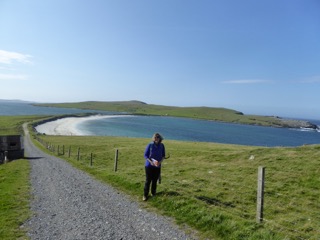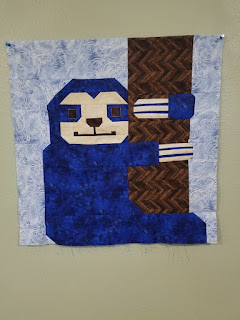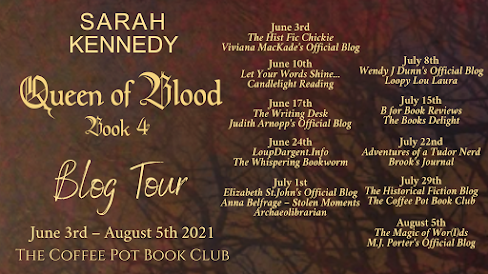Archaeology
student Noah scrapes the soil near Hadrian’s Wall,
once a barrier that divided Roman Britannia from wild Caledonian tribes, in the
hope of uncovering an ancient artefact around which he can build a
project-defining story.
He makes an
intriguing find, but hasn't anticipated the distraction of becoming the object
of desire in a developing love triangle in the isolated academic community at
Vindolanda. He’s living his best
life, but must learn to prioritise in a race against time to solve an
astounding 2,000-year-old riddle, and an artefact theft, as he comes to realise
his future career prospects depend on it.
In the same
place, almost 2,000 years earlier, Centurion Gaius Atticianus, hungover and
unaware of the bloody conflicts that will soon challenge him, is rattled by the
hoot of an owl, a bad omen.
These are
the protagonists whose lives will brush together in the alternating strands of
this dual timeline historical novel, one commencing his journey and trying to
get noticed, the other trying to stay intact as he approaches retirement.
How will the
breathless battles fought by a Roman officer influence the fortunes of a
twenty-first century archaeology mud rat? Can naive Noah, distracted by the
attentions of two very different women, navigate his way to a winning
presentation?
Find out in
Tim Walker's thrilling historical dual timeline novel, Guardians at the Wall.
Buy
Links
Kindle Paperback
Available on
Kindle Unlimited
¸.•*´¨)✯ ¸.•*¨)
✮ ( ¸.•´✶
Excerpt
[archaeology
student, Noah, visits the Head of Archaeology for her opinion on his find]
I
skirted around the two-storey sandstone building and ducked through a doorway
into a well-lit reception area and stood before Mavis, the marketing assistant.
“Hi
Mavis, is Maggie in?” I chirped, picking up the latest issue of Archaeology
Magazine. Professor Maggie Wilde was pictured on the cover, standing on the
battlements of the reconstructed section of wall, gazing northwards towards the
unconquered barbarians. She was already a celebrity archaeologist and would
have made the perfect foil for Harrison Ford’s movie character, Indiana Jones,
with her wild, windswept strawberry blonde hair framing a striking face with
cute freckles across her nose, and twinkling pale blue eyes. Her glossy lips
suggested she knew the value of a warm smile or pout in a room full of men.
‘It’s like fancying your mum’s friend’, Dave had once remarked.
“She’s
on a conference call to the States. Wait if you like, she’ll be finished soon,”
Mavis replied, in a cultured Edinburgh accent. Posh Scottish.
“She’s
the pin-up girl of British archaeology,” I quipped, flashing the magazine
cover.
“I
don’t know what she uses to keep her skin so flawless,” Mavis sighed.
“Perhaps
she discovered an ancient potion?” I offered, flicking through the pages to the
article. I had been hovering around when the photographer had taken her photos
that day – maybe I was in the background of one of the pictures? I sat and
read. ‘Hadrian’s Wall Gives Up Its Secrets’, the headline declared. The
Vindolanda reading tablets were described as ‘the find of the century.’ My
broad idea for my dissertation was for it to be based on translations from some
of the tablets – those that related to the lives and living conditions of the
soldiers garrisoned at Vindolanda and other forts in the early years of
Hadrian’s Wall. I had been cropped out of the photos.
“They
couldn’t have been more excited if they’d discovered Moses’s tablets,” I
quipped.
“You
can go in now,” Mavis said, her voice dragging me away from the article. I had
read half of it, and resolved to return to it when I came out.
Professor
Maggie Wilde’s room was bigger than the reception area, with two walls given
over to floor-to-ceiling bookshelves – one with books and the other with boxes
of academic reports and maps. No doubt Mavis had labelled and sorted them, as
Maggie gave the air of being disorganised. She was an anomaly – a successful
career academic who reputedly hated being tied down to boring tasks, like
report-writing, collating documents, copying, and filing; a creative
free-thinker who was skilled at persuading others to unburden her of boring or
repetitive tasks. She held two positions – Head of Archaeology at the Trust,
and part-time Archaeology Professor at Newcastle University.
“Ah,
Noah, come in. Just move those over there and sit,” she said, pointing to a
couch piled high with maps and printouts. I moved the items and sat, twiddling
my thumbs, watching the crown of her ginger head, waiting until she looked up.
I had literally bumped into her at the student placement reception a few days
earlier, and she had welcomed me with a firm handshake. I had blurted that I’d
seen her Hadrian’s Wall documentary on television, feeling like a needy fan as
soon as I’d said it. She had smiled and asked me what I hoped to achieve during
my placement and listened intently, planting her stylish heels as if she had
nowhere else to go, a strange thing in a room where people were mingling in
groups. I was grateful for her full attention and pleased when she invited me
to call on her expertise any time.
“If
it’s a bad time I can come back?” I offered.
“There
never seems to be a good time, so now will do,” she said, removing her reading
glasses and fixing me with a warm and welcoming smile. “I’ve just had a
two-hour conference call with members of the US Archaeological Society, so I
could do with a distraction.” She leaned forward and picked up the marble
figure Mike had brought to her hours earlier. He must have thoroughly cleaned
and polished it before presenting it to her.
“I
just wanted to hear what your thoughts are on that little lady,” I said. “Do
you think she’s a female deity?”
She
turned it over in her slender fingers and her shoulders twitched. “Ooh, I felt
a slight shock, like static on a jumper,” she said, placing it gently on her
blotter. “Yes, most likely female, judging by the full-length robe. The slight
tummy bump suggests she might be pregnant, so perhaps a fertility symbol. I’ll
send it to the curator at the Hancock Museum for her opinion. She’ll give me a
better idea of where it fits into the Brigantes’ belief system. Some of their
gods were twinned with Roman deities as the polytheistic Romans were keen to
encourage local worship in their temples. Once we know roughly how old it is,
we can look for other carvings or figures from that period and make a guess as
to which deity it is. I agree with Mike; it could be a goddess whom the
household would supplicate for good fortune, fertility, or protection from evil
spirits. Come and sit in the chair.”
*****
[At
the same location in the year 180 CE, Roman centurion, Gaius Atticianus returns
home after a fractious meeting to be confronted by his wife, Aria]
He
entered his courtyard in a state of shock to be met by Aria, legs apart in her
combative stance, holding the Brigantia effigy in one hand, a look of anger in
her eyes.
“What
do you mean by sending Paulinus to give me this carving of the local goddess,
Brigantia? You know full well that we have a shrine to the water goddess of my
people, Sulis, who is twinned with your goddess Minerva, and is the deity who
watches over this house and our family! Have you forgotten the time our prayers
and the healing waters of Sulis restored our little Brutus when he had the
sweating fever?”
“Sulis
be praised. But my love, it was a gift from the wife of my scout whom we saved
from despoilment and murder,” Gaius replied in his well-practised conciliatory
tone. She had resurrected the unhappy memory of his fears that his little son
would succumb to the same fever that had robbed him of his first family.
“Then
you have kept your promise and delivered it to me. But it cannot remain here,
or our own goddess will desert us. You shall not see it again and do not ask me
about it.” Gaius knew not to argue further when her temper was raised. She
looked both magnificent and terrifying when her red mane was raised and her
crystal eyes turned icy with rage. But like the storms of Britannia, it would
soon blow out and she would be his sweet Aria again.
“You
are wise, as always, my love,” he whispered, now more eager than ever to soak
his weary bones and clear his troubled mind. He would withhold his bad news
from her and mull it over. Gaius skirted around her and went to the kitchen to
seek out Longinus to make preparations for his bath. He would be up at dawn to
prepare once again for battle with the Caledonii, or to lead a guard to Coria with
their wives, cohort valuables, and the report blaming him for the attack. But
that was tomorrow. Tonight, he would eat with his family and sleep in the arms
of his beloved Aria.
Tim Walker
Tim Walker is an independent author
living near Windsor in the UK. He grew up in Liverpool where he began his
working life as a trainee reporter on a local newspaper. After studying for a
degree in Communication studies he moved to London where he worked in the
newspaper publishing industry for ten years before relocating to Zambia where,
following a period of voluntary work with VSO, he set up his own marketing and
publishing business. He returned to the UK in 2009.
His creative writing journey began in
earnest in 2013, as a therapeutic activity whilst recovering from cancer
treatment. He began writing an historical fiction series, A Light in the Dark
Ages, in 2014, inspired by a visit to the part-excavated site of a former Roman
town. The series connects the end of Roman Britain to elements of the Arthurian
legend and is inspired by historical source material, presenting an imagined
history of Britain in the fifth and early sixth centuries.
The last book in the series, Arthur, Rex
Brittonum, was published in June 2020. This is a re-imagining of the story of
King Arthur and follows on from 2019’s Arthur Dux Bellorum. Both titles are
Coffee Pot Book Club recommended reads. The series starts with Abandoned
(second edition, 2018); followed by Ambrosius: Last of the Romans (2017); and
book three, Uther’s Destiny (2018). Series book covers are designed by Canadian
graphic artist, Cathy Walker.
Tim has also written three books of
short stories, Thames Valley Tales (2015), Postcards from London (2017) and
Perverse (2020); a dystopian thriller, Devil Gate Dawn (2016); and three
children’s books, co-authored with his daughter, Cathy – The Adventures of
Charly Holmes (2017), Charly & the Superheroes (2018), and Charly in Space
(2020).
Connect with Tim
Website Goodreads Amazon Author Page Facebook Twitter Instagram
Newsletter sign-up and free short story

































